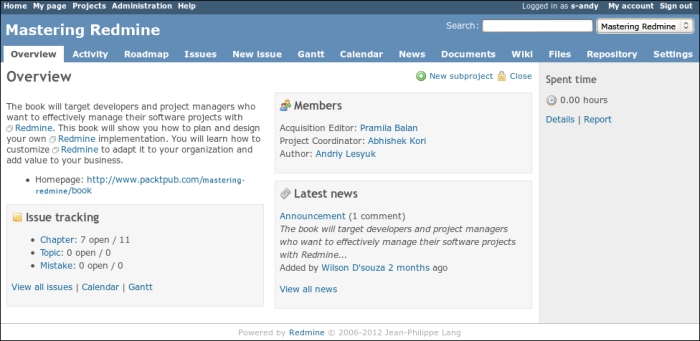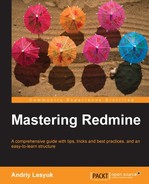Having created a project you noticed that three tabs appeared that we have not reviewed yet. All these tabs are not provided by modules but are parts of the project itself. These are the Overview, Activity and Settings tabs. If all project modules are disabled, there will be only these three tabs (but the Settings tab will be visible only to project managers).
The Settings tab will be discussed in the next topic, right now let's speak about the Overview and Activity tabs.
The overview page is the project start page, therefore, it collates information that can be of interest for users. However, users who are using Redmine intensively rarely come to this page as they know where else they can find the information they need. But new project users, especially the first time users, come to this page more often. So it can be concluded that the overview page is intended mostly for new users. But, still, this page contains information which you won't find elsewhere.
So let's check the Overview tab:

The description of the project, that you see under the Overview label, is what we specify in the Description field of the project form. Below the description, you see the value of the Homepage field. To the right from the Overview label, there is the New subproject link which opens the new project form with the Subproject of field set to this project. All these elements are already known to you.
Near the New subproject link, you see the Close link, which will be mentioned later in this chapter. On the sidebar, you see the grand total of the time spent on this project. This is related to the Time tracking module and we will discuss it in the next chapter.
And now let's speak about blocks. The content of the Latest news block also should be familiar to you as it contains the latest news provided by the News module, which was discussed before. This block also contains the View all news link, which actually redirects you to the News tab.
The next two blocks are available only on this page. The Issue tracking block lists the number of open and total (open plus closed) issues for each tracker in the project. Clicking on the tracker, you will be redirected to the issue list with the issue filter set to show only issues of this tracker.
The Members block lists all project members grouped by their roles. Project managers and administrators can see this information also in the project settings but usual users can find it only here.
At very first glance the activity page may seem to be odd as it just contains a short summary of the latest actions in the project and this information is also available elsewhere. Moreover, Redmine allows users to watch or subscribe to the actions of the objects they are interested in.
But what if you missed some notifications or there were too many notifications? In this case, you can always check the activity page and filter actions to find what you need. This is especially useful if you don't use notifications or you are interested in all events in the project (you don't have to be its manager for this).
The activity page, I'm talking about, is available under the Activity tab:

By default, the activity page shows the summary of the events in the project for the last 30 days, but the number of days can be changed using the Days displayed on project activity option in Administration | Settings | General. In the preceding screenshot, you can see the dates, for which activities are shown, under the Activity title. At the bottom of the activity list, you can see the Previous link. This link allows you to move to the previous 30 days (that is, before 02 Jul). If you move there, to the right from the Previous link, the Next link will appear allowing you to move back. Using these links you can navigate the history of the project events.
The sidebar of the activity page contains the already mentioned filter that allows you to define what kind of events you want to see. Most of the event types, available in this filter, do not need any explanation so let's review only the ones which are less obvious. Thus, if the Issues checkbox is checked, the activity list includes issue status changes and notes. If the Changesets checkbox is set, the list will also include repository commits and if the Messages checkbox is selected you will also see messages posted to forums (including topics, replies, and so on).
In the earlier screenshot, it is not obvious which activity is for what event type. Different event types on this page have different icons and, thus, using this page more you will learn how to recognize the event type. Meanwhile let me tell you what events are shown on this screen.
The first entry for Today is news posted by Wilson. Below is the issue status change and note. All entries for 28 Jul are files added under the Files tab. And an entry for 18 Jul is a document added under the Document tab.
In addition you can subscribe to the activity feed by using the Atom link below the list.
Once you get used to this page you will love the listing as it's compact, easy-to-read and supports the filter—there is no easier way to check the latest events for project.
Tip
Global activities
There is also the global activity page that shows events on all projects (to which a user has access, of course). This page can be useful for employees who work on different projects. For example, company directors, who want to know what's happening on all projects. To get there, click on the Projects top-menu item and then the Overall activity link.
